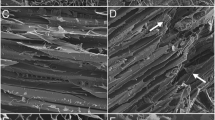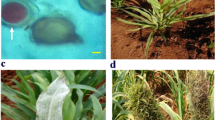Abstract
The danger of Sclerotium cepivorum lies in the strength of its survival structure: sclerotia. Sclerotia comprising hardened mycelium contains food reserves that allow it to remain dormant for long period, which makes the sclerotia-infested soil useless to grow any crop of the Allium species, including onion and garlic. This paper would be the first report on the application of two-photon fluorescence microscopy to the analysis of the structure of sclerotia from S. cepivorum. For this study and, in order to test the method, two different types of sclerotia were used: (1) sclerotia isolated from naturally infested soil and (2) sclerotia produced in vitro (from 20-day-old cultures). Both types of sclerotia were processed by cryopreservation and eight µm histological cuts were used to obtain an autofluorescence image. For both sclerotia, the fluorescence spectrum has three peak signals at their wall. Sclerotia from infested soil presented fluorescence peaks at 400–436, 436–475, and 515–575 nm, while signals from sclerotia produced in vitro presented fluorescence peaks at 400–442, 500–600, and 655–700 nm. Peaks at the violet electromagnetic region (400–436 and 400–442) are like that of the signals reported by the melanin. This study showed that two-photon microscopy is a novel and valuable tool for the study of sclerotia structure and their fluorescence signal, and the possibility of using it as a specific marker to direct detection in the field should be explored.


Similar content being viewed by others
References
Benkeblia N (2005) Free-radical scavenging capacity and antioxidant properties of some selected onions (Allium cepa L.) and garlic (Allium sativum L.) extracts. Braz Arch Biol Technol 48(5):753–759. https://doi.org/10.1590/S1516-8913200500060011
Harper GE, Frampton CM, Stewart A (2002) Factors influencing survival of sclerotia of Sclerotium cepivorum in New Zealand soils. N Z J Crop Hortic Sci 30(1):29–35. https://doi.org/10.1080/01140671.2002.9514196
Maude RB (1990) Leaf diseases of onions, vol II. CRC Press Inc., Boca Raton, FL
Coley-Smith JR, Mitchel CM, Sansford EC (1990) Long-term survival of sclerotia of Sclerotium cepivorum and Stromatinia gladioli. Plant Pathol 39(1):58–69. https://doi.org/10.1111/j.1365-3059.1990.tb02476.x
Backhouse D, Stewart A (1988) Large sclerotia of Sclerotium cepivorum. Trans Br Mycol Soc 91(2):343–346. https://doi.org/10.1016/S0007-1536(88)80226-2
Slade EA, Fullerton RA, Stewart A, Young H (1992) Degradation of the dicarboximide fungicides iprodione, vinclozolin and procymidone in Patumahoe clay loam soil, New Zealand. Pestic Sci 35(1):95–100. https://doi.org/10.1002/ps.2780350114
McLean KL, Swaminathan J, Stewart A (2000) Increasing soil temperature to reduce sclerotial viability of Sclerotium cepivorum in New Zealand soils. Soil Biol Biochem 33(2):137–143. https://doi.org/10.1016/S0038-0717(00)00119-X
Chapuis AF, Ballou ER, MacCallum DM (2019) A bright future for fluorescence imaging of fungi in living hosts. J Fungi 5(2):29. https://doi.org/10.3390/jof5020029
New CM, Coley-Smith JR (1984) Scanning electron microscopy of sclerotial germination in Sclerotium cepivorum. Trans Br Mycol Soc 83(4):690–693. https://doi.org/10.1016/S0007-1536(84)80189-8
Willetts JJ (1969) Structure of the outer surfaces of sclerotia of certain fungi. Archiv für Mikrobiologie 69(1):48–53. https://doi.org/10.1007/BF00408562
Entwistle AR (1990) Root diseases. In: Rabinowitch HD (ed) Onions and allied crops vol. II: agronomy biotic interactions. CRC Press, Boca Raton
Zarani F, Chistias C (1997) Sclerotial biogenesis in the basidiomycete Sclerotium rolfsii. A scanning electron microscope study. Mycologia 89(4):598–602. https://doi.org/10.1080/00275514.1997.12026824
Bullock S, Willetts HJ (1996) Ultrastructural and histochemical studies on mycelial germination of sclerotia of Sclerotinia minor. Mycol Res 100(5):561–570. https://doi.org/10.1016/S0953-7562(96)80009-8
Sadeh R, Kritzman G, Chet I (1985) The ultrastructure of resting and germinating sclerotia of Botrytis allii. Bot Gaz 146(3):302–307
Arseniuk E, Macewicz J (1994) Scanning electron microscopy of sclerotia of Sclerotinia trifoliorum and related species. J Phytopathol 141(3):275–284. https://doi.org/10.1111/j.1439-0434.1994.tb01471.x
Pérez-Moreno L (1999) Estructura poblacional de Sclerotium cepivorum Berk en México, Tesis de Doctorado, CINVESTAV, Irapuato, GTO
Luo G, Mitchell TG (2002) Rapid identification of pathogenic fungi directly from cultures by using multiplex PCR. J Clin Microbiol 40(8):2860–2865. https://doi.org/10.1128/JCM.40.8.2860-2865.2002
Valdés-Santiago L, Ordaz-Arias A, Herrera-Pérez G, Vargas-Bernal R (2018) Isolation and quantification of sclerotia of Sclerotium cepivorum from contaminated soil: improvement of determination protocol. Rev Csc Nat Agrop 5(17):13–17
Willetts HJ, Bullock S (1992) Developmental biology of sclerotia. Mycol Res 96(10):801–816. https://doi.org/10.1016/S0953-7562(09)81027-7
Chet I, Henis Y, Kislev N (1969) Ultrastructure of sclerotia and hyphae of Sclerotium rolfsii Sacc. J Gen Microbiol 57(2):143–147. https://doi.org/10.1099/00221287-57-2-143
Jones D (1970) Ultrastructure and composition of the cell walls of Sclerotinia sclerotiorum. Trans Br Mycol Soc 54(3):351–360. https://doi.org/10.1016/S0007-1536(70)80148-6
Saito I (1974) Utilization of β-glucans in germinating sclerotia of Sclerotinia sclerotiorum (Lib.) de Bary. Jpn J Phytopathol 40(4):372–374. https://doi.org/10.3186/jjphytopath.40.372
Kanellis VG (2019) A review of melanin sensor devices. Biophys Rev 11:843–849. https://doi.org/10.1007/s12551-019-00581-8
Nosanchuk JD, Stark RE, Casadevall A (2015) Fungal melanin: what do we know about structure? Front Microbiol 6:1463. https://doi.org/10.3389/fmicb.2015.01463
Eisenman HC, Casadevall A (2012) Synthesis and assembly of fungal melanin. Appl Microbiol Biotechnol 93(3):931–940. https://doi.org/10.1007/s00253-011-3777-2
Littley ER (1992) Sclerotia of Sclerotium cepivorum: factors affecting their formation, survival and infection of onions. Ph.D. Thesis, Biol. Science, Simon Fraser University, Burnaby, BC, Canada
Hadar Y, Henis Y, Chet I (1981) The potential for the formation of sclerotia in submerged mycelium of Sclerotium rolfsii. J Gen Microbiol 122(1):137–141. https://doi.org/10.1099/00221297-122-1-137
Elsheshtawi M, Hatamleh AA, Saad AM, Elgorban AM (2014) Selective Sclerotium cepivorum growth agar media and other condition factors affecting. J Pure Appl Microbiol 8(4):2785–2790
Wu BM, Subbarao KV, Liu Y-B (2008) Comparative survival of sclerotia of Sclerotinia minor and S. Sclerotiorum. Phytopathology 98:659–665. https://doi.org/10.1094/PHYTO-98-6-0659
Raimondi V, Palombi L, Cecchi G, Lognoli D, Trambusti M, Gamoiu J (2007) Remote detection of laser-induced autofluorescence on pure cultures of fungal and bacterial strains and their analysis with multivariate techniques. Opt Commun 273(1):219–225. https://doi.org/10.1016/j.optcom.2006.12.013
Capozzi V, Perna G, Carmone P, Gallone A, Lastella M, Mezzenga E, Quartucci G, Ambrico M, Augelli V, Biagi PF, Ligonzo T, Minafra A, Schiavulli L, Pallara M, Cicero R (2006) Optical and photoelectronic properties of melanin. Thin Solid Films 511–512:362–366. https://doi.org/10.1016/j.tsf.2005.12.065
Tarangini K, Mishra S (2014) Production of melanin by soil microbial isolate on fruit waste extract: two step optimization of key parameters. Biotechnol Rep 4:139–146. https://doi.org/10.1016/j.btre.2014.10.001
Rajagopal K, Kathiravan G, Karthikeyan S (2011) Extraction and characterization of melanin from phomopsis: a phellophytic fungi isolated from Azadirachta indica A. Juss. Afr J Microbiol Res 5(7):762–766. https://doi.org/10.5897/AJMR10.514
Bochenek K, Gudowska-Nowak E (2003) Electronic properties of random polymers: modeling optical spectra of melanins. Acta Phys Pol B 34:2775–2790
Zonios G, Dimou A (2008) Melanin absorption spectroscopy: new method for noninvasive skin investigation and melanoma detection. J Biomed Opt. DOI 10(1117/1):2844710
Sánchez-Pale JR, Zavaleta-Mejía E, Mora-Aguilera G, Pérez-Moreno L (2000) Variability of four Mexican isolates of Sclerotium cepivorum Berk. Rev Mex Fitopatol 18:103–110
Sammour RH, Mahmoud A-G, Mustafa AA, Alhoziem R (2011) Biology, controlling and genetic variability in Sclerotium cepivorum Berk; the causal agent of Allium white rot disease. Curr Trends Microbiol 7:101–111
Acknowledgements
This work forms part of the Integral Program for Strengthening Academic Groups of the PRODEP program (PIFOCA 2017). Many thanks to Dr. Lino Sánchez-Segura for microscopic analysis and thanks to the SOLENA Company for collecting and providing soil samples. We are grateful to MSc María Karina Manzo-Valencia for their invaluable help in technical assistance. Ayabeth Ordaz-Arias received a scholarship granted by SICES through the agreement SICES/CONV/140/2018 ITESI during XI State Summer Research. Laura Valdés-Santiago and Rafael Vargas-Bernal (He reviewed the English translation of the document and realized the photonic analysis) are members of the National System of Researchers (SNI), Mexico.
Author information
Authors and Affiliations
Corresponding author
Ethics declarations
Conflict of interest
The authors declare that they have no conflict of interest.
Additional information
Publisher's Note
Springer Nature remains neutral with regard to jurisdictional claims in published maps and institutional affiliations.
Rights and permissions
About this article
Cite this article
Valdés-Santiago, L., Vargas-Bernal, R., Herrera-Pérez, G. et al. Application of Two-Photon Microscopy to Study Sclerotium cepivorum Berk Sclerotia Isolated from Naturally Infested Soil and Produced In Vitro. Curr Microbiol 78, 749–755 (2021). https://doi.org/10.1007/s00284-020-02341-4
Received:
Accepted:
Published:
Issue Date:
DOI: https://doi.org/10.1007/s00284-020-02341-4




